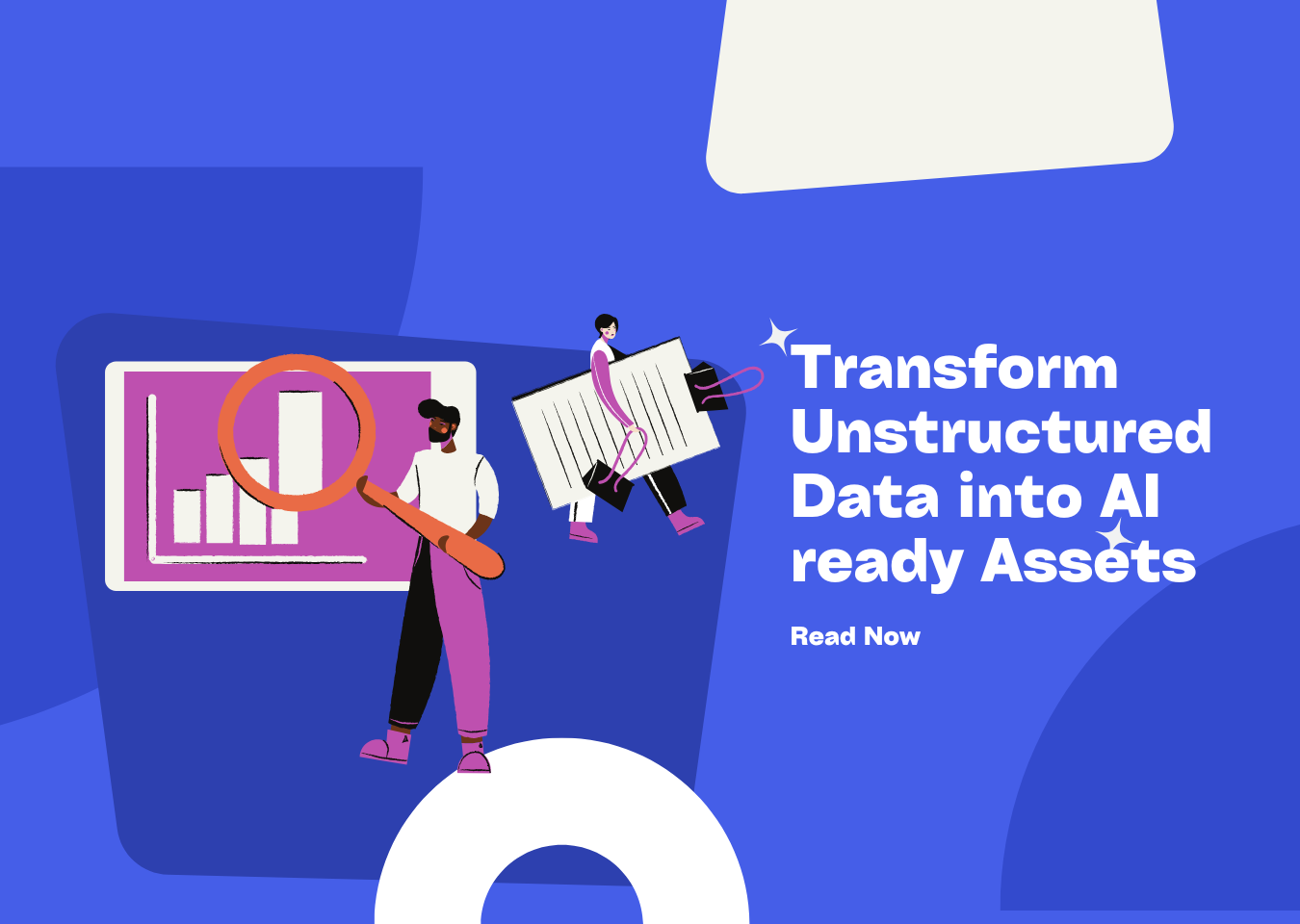Integrating AI Agents with Data: A Comprehensive Guide


Introduction
The AI agent market isn’t just growing; it’s exploding. Projections estimate it will reach a staggering $47.1 billion by 2030. These intelligent systems, designed to automate tasks and enhance decision-making, are rapidly transforming industries. However, AI agents, sophisticated as they are, are only as good as the data they access. Without seamless data integration, their potential remains untapped. This is particularly true when dealing with unstructured data, which makes up a significant portion of the information available to businesses.
This article explores the intricate relationship between AI agents and data, diving into the challenges and opportunities that arise when integrating these two critical components. Consider this your guide to practical insights and best practices to ensure your AI agent implementations are not just successful but transformative. For AI application creators and those in the RAG (Retrieval-Augmented Generation) ecosystem, mastering this integration is paramount.
Understanding AI Agents
What are AI Agents?
At their core, AI agents are autonomous entities designed to perceive their environment, reason about it, and take actions to achieve specific goals. They consist of several key components: perception (gathering information), reasoning (processing information), and action (executing decisions). Think of a self-driving car: an AI agent that uses sensors (perception), algorithms (reasoning), and actuators (action) to navigate roads.
AI agents come in various forms, each with its own level of sophistication. These include simple reflex agents (reacting to immediate stimuli), model-based agents (using internal models to predict outcomes), goal-based agents (striving to achieve specific goals), utility-based agents (optimizing for maximum utility), and learning agents (improving performance over time through experience). From chatbots providing instant customer support to autonomous vehicles navigating complex terrains, AI agents are revolutionizing industries across the board.
How AI Agents Interact with Data
AI agents are data-intensive. They rely on vast amounts of information to learn, adapt, and make informed decisions. This interaction involves several key steps: data ingestion (collecting data from various sources), data processing (cleaning and transforming data), and data analysis (extracting insights and patterns). A major challenge lies in the fact that 80-90% of enterprise data is unstructured, existing in formats like PDFs, emails, and documents.
APIs (Application Programming Interfaces) and data connectors play a crucial role in this process, enabling AI agents to seamlessly access and utilize data from different systems. However, this also raises important considerations around data governance and security, ensuring that data is used responsibly and ethically. Protecting sensitive data is paramount. Transforming this unstructured data into a usable format is where solutions like UndatasIO become invaluable, turning raw information into AI-ready assets.
The Importance of Data Integration
Why Data Integration is Crucial for AI Agents
Data integration is the backbone of any successful AI agent implementation. It ensures that AI agents have access to the right data, at the right time, and in the right format. This leads to several key benefits: improved accuracy and reliability (reducing bias in AI models), enhanced decision-making capabilities (providing real-time insights), and enabling personalized experiences (tailoring recommendations to individual users).
Imagine a financial institution using an AI agent to detect fraudulent transactions. Without integrated data from various sources (e.g., transaction history, credit scores, geolocation), the AI agent would be unable to accurately identify suspicious activity, leading to false positives or missed detections. Furthermore, consider the added complexity if crucial data resides within unstructured documents.
Challenges of Data Integration
Despite its importance, data integration is often a complex and challenging undertaking. Data silos (isolated pockets of information) and inconsistencies (different data formats, naming conventions) are common obstacles. Legacy systems (outdated infrastructures) and a lack of APIs further complicate matters. These challenges are amplified when unstructured data is involved, requiring specialized tools and techniques for extraction and transformation.
Data security and compliance (GDPR, CCPA, HIPAA) add another layer of complexity, requiring organizations to implement robust security measures and adhere to strict regulatory requirements. Overcoming these challenges requires a strategic and well-planned approach. This is where UndatasIO shines, offering a streamlined solution to convert unstructured data into a structured, AI-ready format, simplifying the integration process.
Strategies for Integrating AI Agents with Data
Data Integration Approaches
Several data integration approaches can be used to connect AI agents with data sources. ETL (Extract, Transform, Load), the traditional approach, is suitable for batch processing, while data virtualization creates a virtual layer over disparate data sources, providing a unified view of data. However, these methods often struggle with the complexities of unstructured data.
API-led connectivity uses APIs to connect AI agents with data sources in real-time, enabling seamless data exchange. Change Data Capture (CDC) captures and propagates data changes in real-time, ensuring that AI agents have access to the most up-to-date information. For handling unstructured data, specialized parsers are often required. While tools like unstructured.io and LlamaIndex parser offer solutions, UndatasIO provides a more comprehensive and efficient approach by focusing on transforming unstructured content into high-quality, AI-ready assets with minimal coding.
Tools and Technologies for Data Integration
A wide range of tools and technologies are available to facilitate data integration. Cloud-based integration platforms (MuleSoft, Dell Boomi, Azure Data Factory, AWS Glue) offer comprehensive capabilities for connecting and integrating data from various sources. These platforms can be enhanced by integrating specialized tools for unstructured data processing.
Data lakes and data warehouses (Snowflake, Amazon Redshift, Google BigQuery) provide centralized repositories for storing and analyzing large volumes of data. AI-powered data integration tools (Databricks, DataRobot) leverage AI and machine learning to automate and optimize the data integration process. By leveraging UndatasIO, you can ensure that your unstructured data is not a bottleneck but a valuable asset in your AI pipeline.
Best Practices for Data Integration
Successful data integration requires adherence to best practices. Data governance and quality are essential for ensuring data accuracy, completeness, and consistency. Security and compliance are paramount for protecting sensitive data and adhering to regulatory requirements.
Scalability and performance are crucial for designing a data integration architecture that can handle growing data volumes and user demands. A well-designed architecture will be able to handle any demand thrown its way. UndatasIO is built for scale, enabling you to process large volumes of unstructured data efficiently and reliably.
Real-World Applications and Use Cases
Examples of Successful AI Agent and Data Integration
The integration of AI agents and data is transforming industries across the board. Customer service automation leverages chatbots to answer customer inquiries and resolve issues, improving efficiency and customer satisfaction. Fraud detection and prevention employs AI agents to identify suspicious transactions in real-time, minimizing financial losses.
Predictive maintenance uses AI agents to predict equipment failures and schedule maintenance, reducing downtime and improving operational efficiency. Supply chain optimization leverages AI agents to optimize inventory levels and delivery routes, reducing costs and improving delivery times.
Case Studies
Companies are increasingly leveraging AI agents and data integration to gain a competitive edge. For example, Adecco uses Salesforce’s Agentforce, a powerful AI tool, to improve its recruitment process, matching candidates with the right job opportunities more efficiently. Imagine the enhanced capabilities if Agentforce could seamlessly process resumes and candidate profiles directly from unstructured documents, a capability readily enabled by UndatasIO.
These successful integrations demonstrate the transformative potential of AI agents when combined with a robust data integration strategy. The result is improved efficiency, reduced costs, and increased revenue.
Overcoming Integration Challenges
Addressing Data Silos and Inconsistencies
Data silos and inconsistencies are significant barriers to effective data integration. Data standardization and cleansing, using data quality tools to identify and correct errors, are essential for ensuring data accuracy. Master data management, creating a single source of truth for critical data elements, helps to eliminate inconsistencies and improve data quality.
Integrating with Legacy Systems
Integrating with legacy systems can be particularly challenging. API wrappers and connectors (developing custom APIs to access data from legacy systems) can bridge the gap. Modernization strategies (migrating data and applications to modern platforms) can provide a long-term solution.
Ensuring Data Security and Compliance
Data security and compliance are non-negotiable aspects of data integration. Data encryption and access controls (protecting sensitive data from unauthorized access) are essential security measures. Compliance with regulations (GDPR, CCPA) and implementing data privacy policies and procedures ensures that data is handled responsibly and ethically.
Future Trends in AI Agent and Data Integration
Emerging Technologies
The field of AI agent and data integration is constantly evolving. Generative AI and large language models (LLMs) are used to generate synthetic data for training AI agents, overcoming data scarcity challenges. Edge computing and AI enable deploying AI agents on edge devices to process data closer to the source, reducing latency and improving performance.
Federated learning allows training AI models on decentralized data without sharing the data itself, preserving privacy and security. These technologies promise to further enhance the capabilities of AI agents and their ability to leverage data.
The Evolving Role of AI Agents
AI agents are becoming increasingly autonomous and intelligent, learning and adapting to changing environments. Collaboration with humans is also becoming more prevalent, with AI agents working alongside humans to solve complex problems. Ethical considerations are paramount, ensuring that AI agents are used responsibly and ethically.
Conclusion
Integrating AI agents with data unlocks a wealth of benefits, including improved efficiency, enhanced decision-making, and personalized experiences. However, a well-planned integration strategy – defining clear goals, selecting the right tools, and involving stakeholders – is essential for success. Don’t let unstructured data be a roadblock; consider leveraging solutions like UndatasIO to transform it into a valuable asset.
AI agents have the potential to transform businesses, creating new opportunities and disrupting existing industries. Embracing AI agent and data integration is no longer a choice but a necessity for organizations looking to thrive in the digital age.
Call to Action
Ready to unlock the power of AI agents and data integration, especially with unstructured data? Try UndatasIO now and see how easily you can transform your raw data into AI-ready assets. Learn More about how we can help you integrate AI agents with your data.
📖See Also
- In-depth Review of Mistral OCR A PDF Parsing Powerhouse Tailored for the AI Era
- Assessment-Unveiled-The-True-Capabilities-of-Fireworks-AI
- Evaluation-of-Chunkrai-Platform-Unraveling-Its-Capabilities-and-Limitations
- IBM-Docling-s-Upgrade-A-Fresh-Assessment-of-Intelligent-Document-Processing-Capabilities
- Is-SmolDocling-256M-an-OCR-Miracle-or-Just-a-Pretty-Face-An-In-depth-Review-Reveals-All
- Can-Undatasio-Really-Deliver-Superior-PDF-Parsing-Quality-Sample-Based-Evidence-Speaks
Subscribe to Our Newsletter
Get the latest updates and exclusive content delivered straight to your inbox